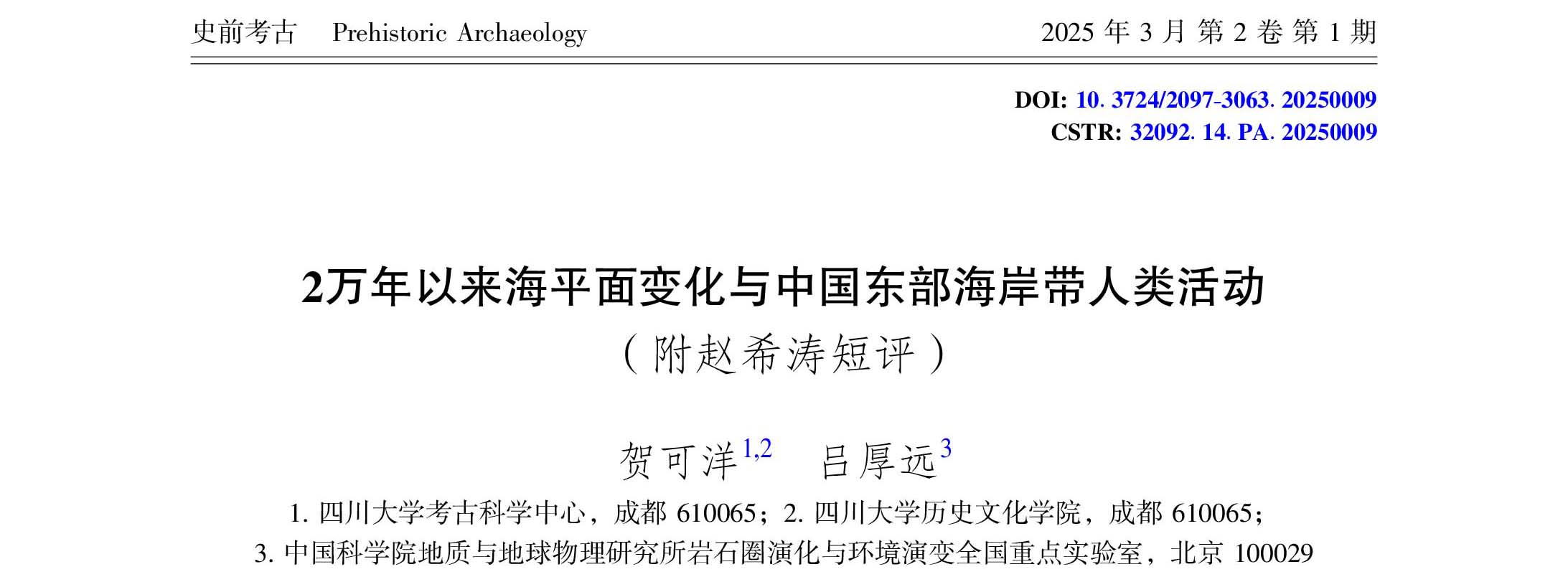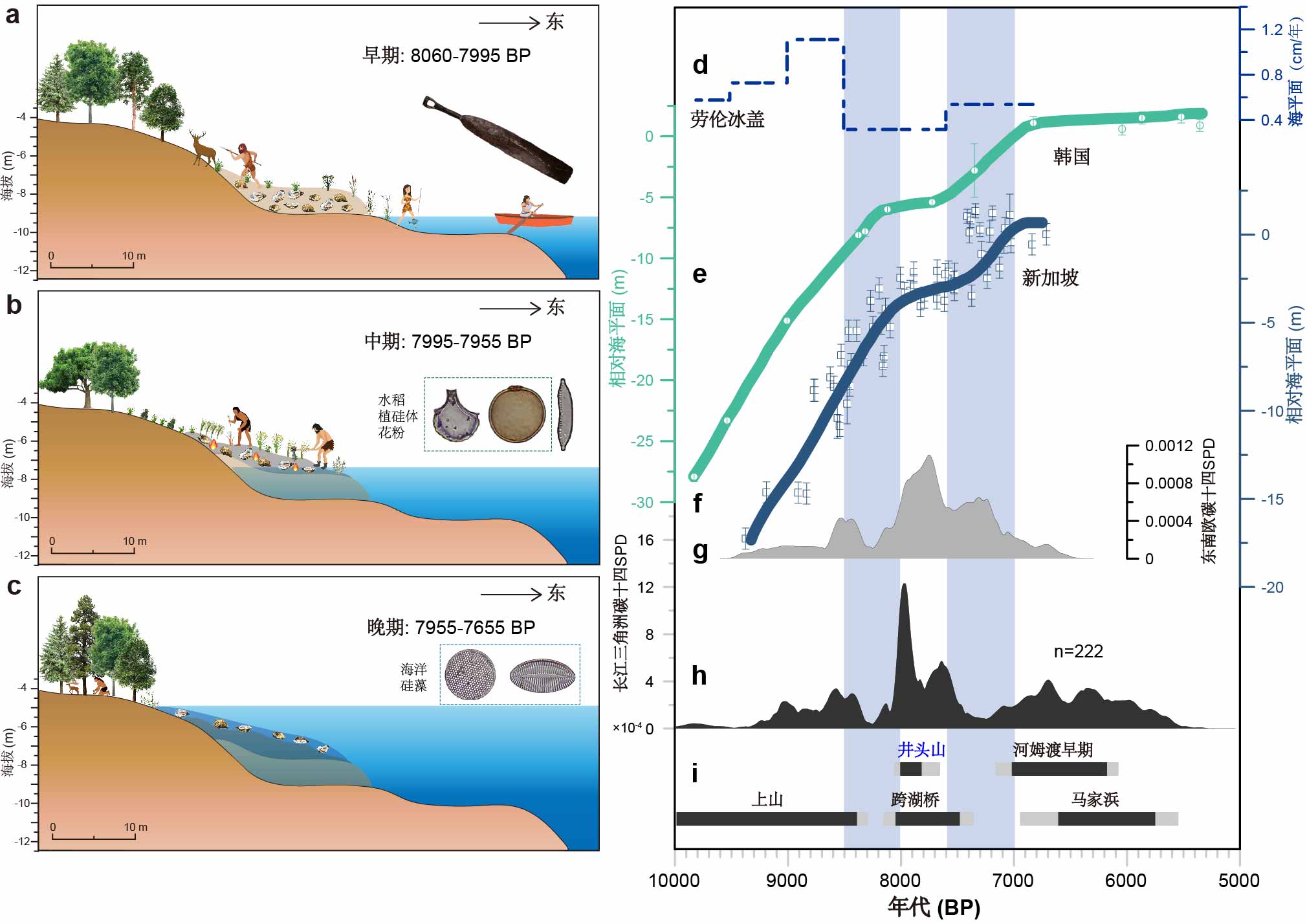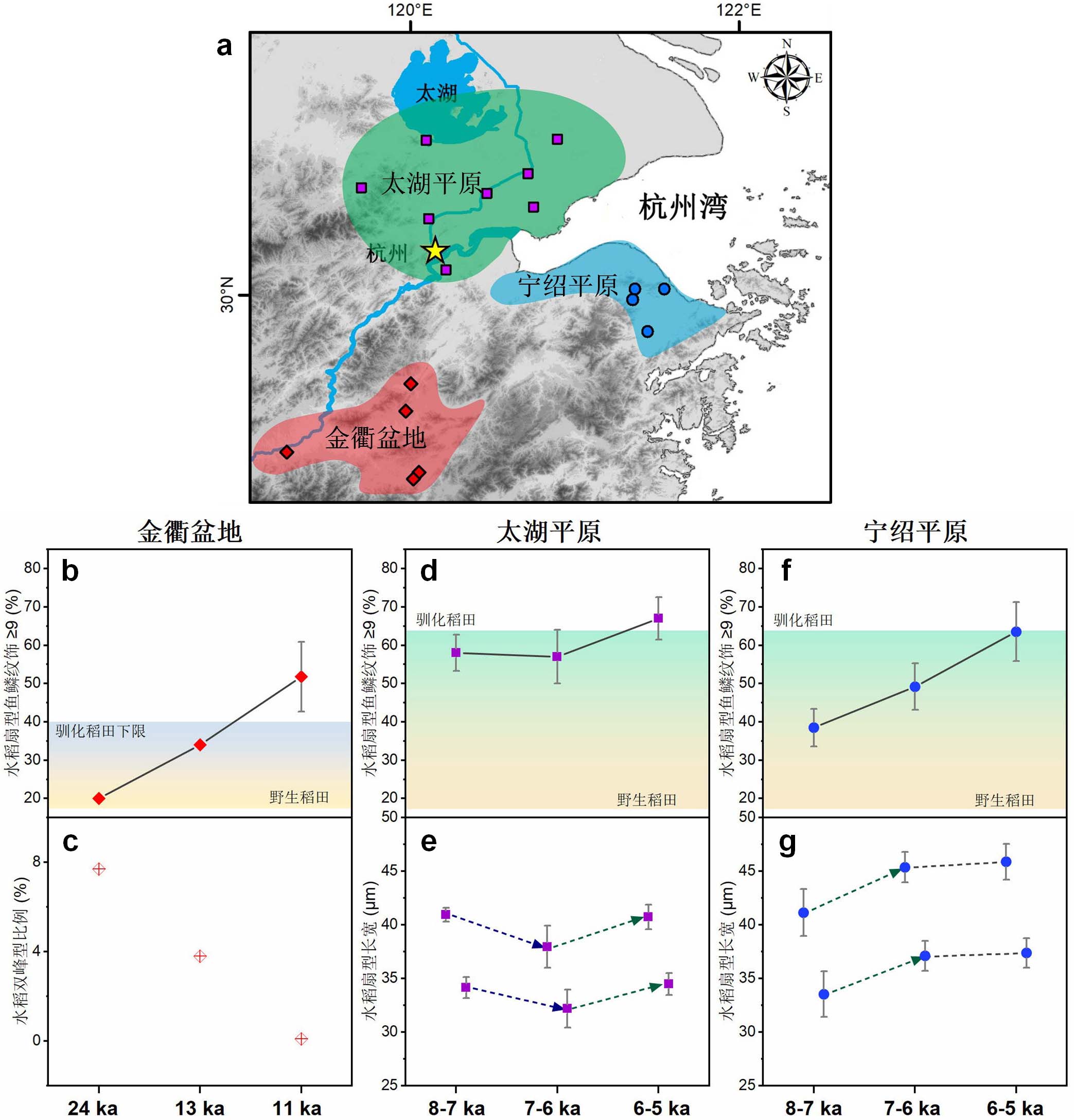The Geoarchaeology Team of the Center for Archaeological Science published "Sea-level changes over the past 20,000 years and human activities in the coastal zone of eastern China" in "Prehistoric Archaeology".

Recently, Associate Research Fellow He Keyang from the Geoarchaeology Laboratory of the Archaeological Science Center at Sichuan University published a paper titled "Sea Level Changes and Human Activities in the Eastern Coastal Zone of China over the Past 20,000 Years" in the journal *Prehistoric Archaeology*. Associate Research Fellow He Keyang from our institute is the first author and corresponding author of this study. The research was primarily funded by the Major Project of the Interdisciplinary Division of the National Natural Science Foundation of China (T2192954) titled "Environmental Changes in Coastal Zones and the Evolution of Culture and Civilization," with secondary and tertiary funding from the General Project (42477479) and Youth Project (41902187) of the National Natural Science Foundation of China, as well as support from the Geological Survey Fund Project of Jiangsu Provincial Bureau of Geology (2024-SGH006).
Since the end of the Last Glacial Period, with rising temperatures and melting ice caps, large-scale marine transgressions have occurred in the mid-to-low latitude coastal zones globally, profoundly impacting human activities in these areas. The sea level change curve for eastern China over the past 20,000 years shows a stepwise fluctuating upward trend. Liu Jingpu and others identified six rapid sea level rise events associated with meltwater pulses (MWP), with intervals of slower sea level rise between these events. Key time points include: 20,000 years ago, when sea level was at -130 m, exposing approximately 1.2 million square kilometers of the eastern continental shelf; 15,000 years ago, when sea level was at -100 m, exposing about 800,000 square kilometers of the continental shelf; and 7,000 years ago, when a high sea level occurred, submerging approximately 130,000 square kilometers of the eastern plains (Figure 1). Focusing specifically on the most debated issue of sea level changes in eastern China since the Holocene, the central point of contention is whether a mid-Holocene high sea level existed. Based on the latest results from drilling on the eastern China coastal continental shelf and archaeological excavations, this paper elucidates the impact of sea level changes on human activities and the adaptation processes of humans from the perspectives of population migration and subsistence patterns.

Figure 1: Relative sea level curve and coastline position in the eastern coastal areas of China over the past 20,000 years.
The blue bars indicate key time nodes of relative sea level rise.
In terms of human migration, pottery shards dating back 15,000 years and rice remains dating back 13,000 years have been discovered on the continental shelf, while pottery shards and rice dating back 10,000 years have been found in coastal zones. These discoveries generally correspond to periods of intermittent sea level rise, suggesting that these intervals of sea level rise may have been critical times for ancient human settlement and activity. Over the past 20,000 years, during periods when the rate of sea level rise slowed, human activity may have existed on the continental shelf and in low-altitude coastal zones. For example, the Jingtoushan site represents primary sedimentary evidence of human activity in the coastal zone (see Figure 2). Additionally, statistical analysis of the elevation of the base layers of the first to fourth phases of the Hemudu culture in the Ning-Shao region shows a gradual increase from approximately -1 meter to about 2 meters, which is significantly higher than the base layer of the Jingtoushan site at about -10 meters. This indicates that humans may have migrated upward as sea levels rose. Synthesizing the above evidence, this provides a new perspective for future underwater archaeology and human-environment relationship studies in coastal zones. It suggests that during periods of slowed sea level rise, earlier human activities or archaeological sites may exist on the nearshore continental shelf and in deeper coastal zones. Furthermore, as coastal areas were submerged by rapid sea level rise events, humans may have migrated to higher-altitude inland regions.

Figure 2: Ecological Environment Evolution of Jingtoushan Site and Early Holocene Sea Level Changes
Blue bars indicate two rapid sea level rise events at ~8.4–8 ka and ~7.6–7 ka BP
In terms of livelihood patterns, based on the understanding of the intermittent rise in sea levels during the early Holocene and multi-indicator analysis of the Jingtoushan site, it has been confirmed that early shell mound accumulations may exist underwater or in marine sediments. Accordingly, we believe that the time when marine adaptation intensified worldwide should be pushed forward to around 8 ka BP. Regarding the relationship between marine adaptation and agriculture, evidence from shell mound sites such as Jingtoushan, Zhuangbianshan, and Huangguashan shows that rice agriculture and marine adaptation coexisted in the lower Yangtze River region and coastal Fujian, possibly together contributing to the dispersal of Austronesian language groups. Additionally, sea level changes have had a profound impact on the domestication of rice. Existing archaeobotanical evidence, especially a series of breakthrough advances in recent years concerning rice fan-shaped phytoliths, indicates that rice domestication in the lower Yangtze River region exhibits a multi-lineage, multi-center geographic mosaic pattern (Figure 3). Influenced by cultural and agricultural interruptions caused by Holocene marine incursions, the proportion of rice in the diet of ancient people decreased, while the proportion of gathering and hunting increased. At the same time, wetlands expanded, wild rice proliferated, population decreased, and domestication pressure weakened, leading to the weedification of rice. The level of rice domestication stagnated or even declined, ultimately resulting in a delay in the completion of rice domestication in coastal areas.

Figure 3: Comparison of Rice Domestication Processes in Different Regions of the Lower Yangtze River
After the article was accepted, Professor Zhao Xitao, a researcher at the Institute of Geology and Geophysics, Chinese Academy of Sciences, and a renowned geomorphologist and Quaternary geologist, wrote a short commentary for this paper. He stated, "Your article provides an excellent summary and review of both its theoretical foundation and the latest advancements"... "Your discovery of pre-transgression ancient cultural relics and rice cultivation traces beneath the post-glacial marine transgression layers in the coastal plains and continental shelf, as well as the advance and retreat of early and mid-Holocene sites in response to sea level fluctuations and shoreline changes, represents the latest progress in research and deserves significant recognition."

Zhao Xitao, former researcher at the Institute of Geology and Geophysics, Chinese Academy of Sciences, has long been engaged in research on coastal geology and sea-level changes, publishing numerous authoritative works. Below is a brief review written by Mr. Zhao Xitao for the paper Sea-Level Changes Since 20,000 Years Ago and Human Activities in the Eastern Chinese Coastal Zone.
Dear Houyuan and Keyang,
Greetings! I have carefully read your excellent work and learned a great deal from it. However, as I am about to turn 85 in a few days, my physical condition is increasingly frail, and my energy is even more limited, so I apologize for the delayed response!
Regarding the sea-level change research I was once familiar with, your paper provides an excellent summary and review of its theoretical foundations and latest developments, from which I have greatly benefited. I am delighted to note that my understanding from the late last century of the principles and progress in sea-level changes since 20,000 years ago—such as the concept and terminology of glacio-eustasy; explanations of sea-level changes caused by changes in ocean surfaces, crustal surfaces, and Earth’s rotation rate; the three models of absolute or global eustatic sea-level (ESL) changes (glacial, tectonic, and gravitational attraction of water mass); the establishment of sea-level change curves and the three types of Holocene sea-level change curves, particularly the two latest global sea-level change models (glacial isostatic adjustment, hydro-isostatic adjustment, and J.A. Clark’s loading model, as well as geoid changes and N-A. Mörner’s gravity model)—remains largely unchanged. In the quarter-century since my retirement, the academic community has only slightly revised its understanding of the timing of the Last Glacial Maximum and the lowest sea-level position, and newly proposed the concept of six rapid sea-level rise events due to meltwater pulses. Your discovery of pre-transgression cultural relics and rice cultivation traces beneath post-glacial transgressive layers in coastal plains and inner shelves, as well as the advance and retreat of early and mid-Holocene sites in response to sea-level fluctuations and shoreline changes, represents the latest progress in research and deserves significant recognition. As for your major advancements in studying the domestication of wild rice, the history of rice origins, and their relationship with sea-level changes, I am a complete outsider but have learned many new things from your work.
Through studying your paper, I have formed or deepened the following concepts or understandings:
Climate is variable, with secondary fluctuations and even smaller oscillations or tremors (astronomical factors) nested within larger fluctuations. Influenced by climate variability, ice caps expand and contract, and glaciers advance and retreat accordingly. Consequently, sea levels rise and fall, with smaller fluctuations or tremors nested within larger changes. As sea levels rise and fall, coastlines advance and retreat, resulting in overall Holocene or post-glacial transgressions and regressions, as well as smaller advances and retreats. Simultaneously, there is an alternation between the deposition and erosion of marine and terrestrial strata. Of course, other geological processes affected by climate variability exhibit a time lag.
Ancient humans followed water and vegetation, as both human and biological survival depend on water sources, and humans could not live apart from the animal and plant resources necessary for survival and reproduction. Plains and low hilly areas were the most suitable places for ancient human habitation. The earliest agriculture, including rice cultivation, likely emerged in these areas.
Due to the enormous sediment loads carried by the Yellow and Yangtze Rivers, as sea levels dropped during the Last Glacial Maximum, vast eastern plains and the continental shelves of the Yellow Sea and East China Sea were formed in eastern China. Numerous rivers and valleys flowed through the eastern and shelf plains toward the continental slope and deep sea, providing vast land and abundant water and vegetation resources. Therefore, it is entirely understandable that ancient humans lived in resource-rich areas of the shelf plains during low sea-level periods. These ancient human sites are inevitably buried beneath later marine deposits or within interlayers below marine strata.
As the post-glacial climate warmed and sea levels rose amidst fluctuations, transgressions occurred at varying rates (whether viewed as a single or multiple high sea-level events, continuous rises, or recent stabilization). Around 7,000–8,000 years ago, the maximum transgression extent was reached, followed by intermittent retreats to the present position. Ancient humans had to migrate in response to sea-level and coastal fluctuations. With sea-level changes and shoreline shifts dominated by regression since the mid-Holocene, human sites are primarily found above Holocene marine strata or within strata above marine layers.
I am unsure if the above opinions are appropriate; they are merely for your reference. Having been largely disconnected from this research for a quarter-century, I know very little now. I feel apprehensive and ashamed! I am deeply grateful to you for sharing such significant results with me. I sincerely wish you greater achievements on your scientific journey!
Respectfully,
Xitao
March 19, 2025
Conducting research on the relationship between sea level changes and human activities not only helps to enhance the understanding of the relationship between environmental changes in China's eastern coastal zone and the origins of agriculture and civilization, but also provides a new research perspective for analyzing the cultural-environmental relationship during the transition from the Paleolithic to the Neolithic period. This paper is a collective achievement of the coastal zone project team led by Researcher Lv Houyuan from the Institute of Geology and Geophysics, Chinese Academy of Sciences. It is published in the special issue of "Prehistoric Archaeology" titled "The Paleolithic-Neolithic Transition and the Origin of Agriculture in East Asia" (Issue 1, 2025). We would like to express our gratitude to Teacher Zhao Xitao, project team members Sun Guoping, Zheng Yunfei, and other teachers, conference organizer Teacher Zhao Hui, as well as Editor Li Qian and the two reviewers from the editorial department.
Original link: https://doi.org/10.3724/2097-3063.20250009
